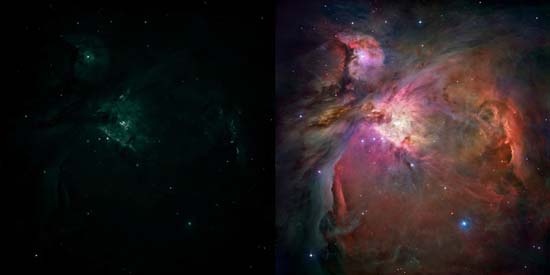NASA also needs 'witch' photoshop
An article published in Discovery Magazine has revealed that NASA's recently released Saturn photos have been processed in photoshop.
Mark Thompson, author of the paper, said that images of Saturn's Titan and Dione, captured by the Cassini spacecraft, recently underwent careful post-processing . Therefore, images that are dark and blurry, after being filtered in blue, red and green, have become brightly colored images as they were published.

Orion constellation before and after color calibration.Photo: Discovery
Mark also said that NASA's corrections to the images of Saturn moons became a scandal that was repeatedly mentioned by the press to criticize and attack. However, according to personal opinion, Mark thinks that it is perfectly normal to have to edit the original photos before publishing them.
This author asserts, ' NASA uses computer software to handle capital-based images is nothing big.' It is like when people use image processing software to eliminate red-eye in error photos. However, 'one can accept post-processing of life images but cannot accept the' modification 'of astronomical images '.
Mark also said that CCD technology has been in common use for 10 years. CCD offers two types of light-sensitive receivers: one color and multiple colors. Compared to these standard color cameras, a color camera is used to filter different colors, thus producing images with greater resolution and more accurate colors.
However, when using CCD technology in spacecraft, the pink, green, and green colors are greatly deviated . Therefore, after having the original photos, these images have to go through post-processing to correct these color differences. ' This is the fastest way to help the public admire beautiful astronomical photographs ,' Mark said.
Besides, after the photos have been processed, many details in the photo are made ' clear '. Therefore, it not only helps the image look better but also helps scientists have more information to serve their scientific research.
Finally, the author asserts: ' We must accept that the eye is usually not the most efficient light-receiving device. Therefore, after being calibrated, the images will give us a feeling of observing more realistic objects . '
- The last witch of England
- Adobe extends online Photoshop services
- The mysterious 'witch mark' in a 60,000-year-old cave
- The mystery of the ancient witch world
- 18 unbelievably beautiful natural photos make viewers mistaken for a Photoshop product
- Install Photoshop on Ubuntu
- Quick start Adobe Photoshop
- 20 perfect photos without photoshop
- Mysterious truth to the incredible world of witches
- 100 beautiful, unbelievable photos, never before photoshop (part 4)
- Why are witches hunted so hard?
- Photoshop Lightroom 1.0 came out
 Van Allen's belt and evidence that the Apollo 11 mission to the Moon was myth
Van Allen's belt and evidence that the Apollo 11 mission to the Moon was myth The levels of civilization in the universe (Kardashev scale)
The levels of civilization in the universe (Kardashev scale) Today Mars, the sun and the Earth are aligned
Today Mars, the sun and the Earth are aligned The Amazon owner announced a secret plan to build a space base for thousands of people
The Amazon owner announced a secret plan to build a space base for thousands of people